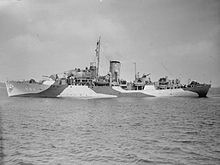HMS Cossack (F03)
|
||||||||||||||||||||
|
||||||||||||||||||||
|
||||||||||||||||||||
|
||||||||||||||||||||
The HMS Cossack ( ship identification : L03, F03, G03) was a (second) Tribal class destroyer of the British Royal Navy . The ship became famous for its role in the so-called Altmark incident in the spring of 1940.
On October 27, 1941, the Cossack sank after a torpedo hit by U 563 while securing convoy HG 75 and an unsuccessful attempt to tow the heavily damaged ship.
The history of the ship
The keel of the ship was laid on June 9, 1936 at the High Walker Yard of Vickers-Armstrongs in Newcastle upon Tyne , followed by the launch on June 8, 1937 , each time together with the sister ship Afridi . She was already the sixth ship to have been named Cossack since 1806. The destroyer Cossack , which belonged to the first Tribal class from 1905 , had last used the name from 1908 to 1919.
On June 7, 1938 the delivery and on June 14, 1938 the final commissioning of the ship as the second of the new class. The destroyer began its service with the Tribal Flotilla of the Royal Navy in the Mediterranean Fleet . She took part in the control of international waters off Spain. On August 2, 1939, the Cossack visited Istanbul with the battleship HMS Warspite .
War missions
On September 3, 1939, the Cossack began securing Allied ships between Marseille and other ports in the Mediterranean. On October 2, the destroyer was ordered from operations in the western Mediterranean to the Home Fleet .
On 16 February 1940, a boarded boarding party of of Philip Vian commanded the vessel, the German supply ship Altmark in Norwegian Jøssingfjord . It freed 303 captured merchant shipmen whose ships had been seized by the Admiral Graf Spee in the South Atlantic. Seven men from the Altmark crew were shot.
A few weeks later, on April 13, 1940, the Cossack with the sister ships Bedouin , Punjabi and Eskimo belonged to the British association, which, under the command of the battleship Warspite, penetrated the Ofotfjord as far as Narvik and the remaining eight there in the second naval battle from Narvik German destroyer sunk or forced to submerge. The Cossack sank the Erich Giese with the Foxhound , but then fell out due to artillery hits by Diether von Roeder and the run-up to a wreck in the harbor. The seven hits killed 11 men on board and 23 were injured, some seriously. She was only released again at high tide and left Narvik with the Kimberley on the 14th. Like the sister ships Punjabi and Eskimo , it could only be transferred to Great Britain for repair after a makeshift repair in a British base in the Skelfjord .
After her return to Great Britain, the Cossack was repaired from April 30th at Thornycroft in Southampton. In addition to repairing the damage, the 120 mm twin gun in the X position was replaced by a 102 mm twin gun, which is more suitable for aircraft defense , and a first radar device was installed. After that, the destroyer was primarily used in the North Atlantic to track down suspected German sea trade troublemakers. In May 1941, as part of the escort protection of the WS-8B convoy , the ship was one of the forces that were supposed to find and sink the German battleship Bismarck . Five destroyers ( Cossack , Maori , Sikh , Zulu and the Polish Piorun ) were withdrawn from the convoy on May 26 to carry out torpedo attacks on the Bismarck during the night . These attacks were unsuccessful, but forced the crew of the German battleship to remain in full combat readiness through the night . After the Bismarck sank the following day, according to legend, the crew of the destroyer took over the Bismarck's cat .
The end of the Cossack
On October 24, 1941, while accompanying convoy HG 75 from Gibraltar to England , the ship was badly damaged by a torpedo hit by U 563 . 159 men of the crew died in this hit and the evacuation of the ship. The corvette Jonquil took over the castaways and stayed with the drifting wreck. The tug HMT Thames attempted to tow the ship back to Gibraltar via the stern on October 25, but the tow rope had to be cut the next day in increasingly bad weather. The destroyer sank on October 27, 1941 west of Gibraltar at position 35 ° 12 ′ 0 ″ N , 8 ° 17 ′ 0 ″ W
Renewed use of the name
On May 10, 1944, a war-building program destroyer running at Vickers-Armstrong's High Walker Yard was again named Cossack . On September 4, 1945, the seventh Cossack entered service with the Royal Navy. The 1885 ts large destroyer was used in East Asia during the Korean War . In spring 1961 the ship was sold for demolition.
Individual evidence
- ^ Rohwer: Chronicle of the naval war. P. 31
- ↑ Rohwer, p. 38f.
- ↑ a fjord in the south of the island Flakstadøy in the municipality Flakstad (Lofoten), where the Royal Navy had set up a makeshift repair station; Core provisional basis was applied German freighter Alster , which should provide the German destroyers in Narvik and now for the Behelfsreparatur the cruiser Penelope used was
- ^ Rohwer, p. 126
- ^ Rohwer, p. 178f.
Web links
literature
- Jürgen Rohwer , Gerhard Hümmelchen : Chronicle of the naval war 1939-1945. Manfred Pawlak, Herrsching 1968, ISBN 3-88199-0097 .
- David Lyon: HMS Cossack / Tribal Class destroyer. Profile Publication, N ° 2, Windsor 1970.



